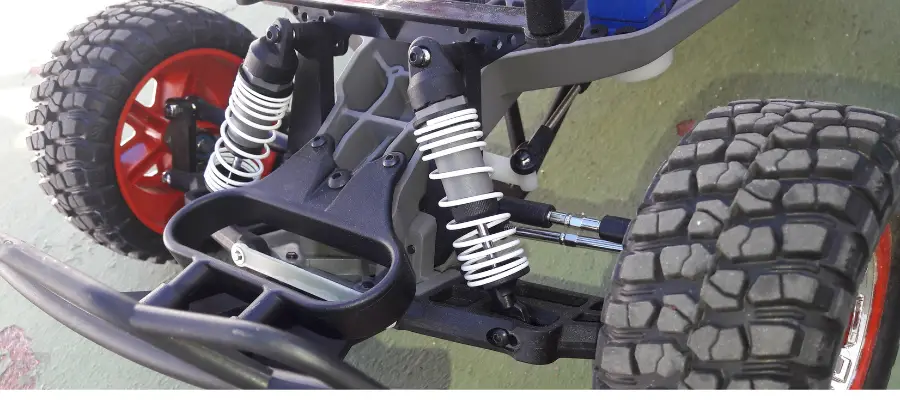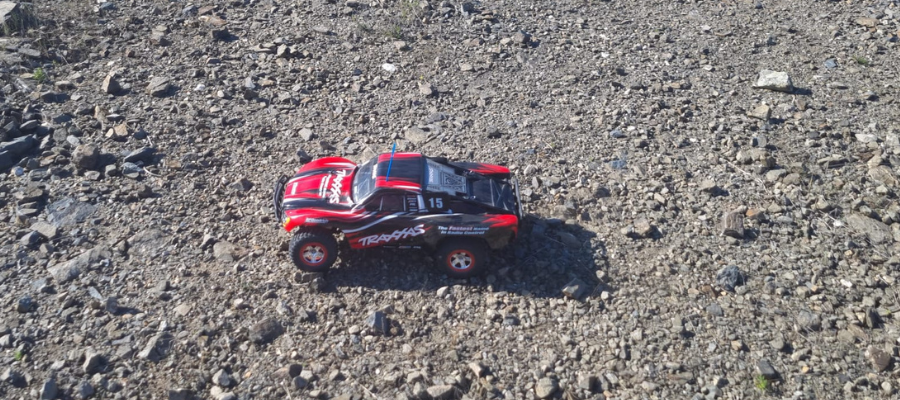RC suspension tuning is an important aspect of optimizing the performance of RC hobbyists and enthusiasts. It involves adjusting the suspension system to enhance the car’s handling, stability, and overall performance on different surfaces and terrains. You can achieve better traction, smoother handling, and faster lap times by tweaking the suspension setup.

Let’s explore the fundamentals of RC suspension tuning and provide tips and tricks to help you get the most out of your RC car’s suspension. If you’re a beginner or an experienced RC enthusiast, this guide will help you understand the basics of RC suspension tuning and how to fine-tune your car for optimal performance.
Parts Of An RC Suspension System
The suspension consists of several parts that work together to provide stability and control to the car while driving. The main components include the shocks, springs, sway bars, camber links, caster blocks, and toe links. To learn in detail, you can read my in-depth guide on RC car suspension types and parts.
The shocks are responsible for absorbing bumps and impacts on the track, while the springs support the weight of the car and determine the ride height. Sway bars help to reduce body roll during cornering, while camber links control the angle of the wheels relative to the ground. Caster blocks affect the car’s steering and stability, while toe links adjust the angle of the wheels with the car’s centerline.
You can adjust each of these components to fine-tune the suspension for different track conditions and driving preferences. Understanding how these parts work together is crucial for achieving optimal performance and handling.
How Each Part Affects The Suspension’s Performance
Shocks
Absorb bumps and impacts on the track, and help to keep the wheels in contact with the ground for better traction and stability.
Springs
Determine the ride height of the car and support its weight. Stiffer springs provide better handling and stability, while softer springs offer more traction on bumpy or uneven surfaces.
Sway Bars
Reduce body roll during cornering, which helps to maintain traction and stability. Thicker sway bars provide more resistance and reduce body roll further.
Camber Links
Control the angle of the wheels relative to the ground. Adjusting camber links affects the car’s grip and cornering ability, with more negative camber providing better grip during cornering.
Caster Blocks
Affect the car’s steering and stability. Increasing caster provides more straight-line stability while reducing caster increases steering response.
Toe Links
Toe-in provides better straight-line stability, while toe-out provides the better cornering ability.
Different Ways To Adjust An RC Suspension System

There are several ways to adjust an RC suspension system to fine-tune its performance and handling. The most common methods include adjusting the shocks, springs, sway bars, camber links, caster blocks, and toe links.
Shocks
Playing around with the oil viscosity and piston size affects how fast the shocks compress and rebound, which can make a huge difference in your car’s stability and handling. Shocks can also be adjusted by changing the shock piston.
Springs
Swapping out your springs for stiffer or softer ones can change your ride height and support, which can affect your car’s handling and stability. Get the right springs for your car and you’ll be cruising like a boss!
Sway Bars
Replacing your sway bars with thicker or thinner ones can impact your car’s body roll, which can affect the stability and traction during cornering.
Camber Links
Fine-tuning your camber links adjusts the angle of your wheels relative to the ground, which can make a difference in your car’s grip and cornering ability. Get those angles just right and you’ll be handling corners like a pro!
Caster Blocks
Tweaking your caster blocks can have an impact on your car’s straight-line stability and steering response.
Toe Links
Adjusting your toe links changes the angle of your wheels with your car’s centerline, which can affect your car’s stability and cornering ability, with toe-in providing better straight-line stability and toe-out providing better cornering ability.
You can also change the ride height of the car by swapping out the shock position. You should also experiment with weight distribution by moving batteries or adding weights to different parts of the car.
Advice For Making Adjustments Based On Track Conditions And Driving Style
Start with a baseline setup: Before making any adjustments, it’s important to have a baseline setup that you’re comfortable with. This will help you identify which areas need improvement based on the track conditions and your driving style.
Identify the problem areas: Pay attention to how your car handles on the track and identify areas where you’re struggling. Is the car bouncing too much? Is it not turning in as quickly as you’d like? Once you’ve identified the problem areas, you can focus your adjustments on those specific areas.
Consider the track conditions: The track conditions can have a significant impact on how your car handles. Is the track bumpy or smooth? Is it high-speed or tight and technical? Adjustments that work well on a smooth track may not work as well on a bumpy track, so be sure to take the track conditions into account when making adjustments.
Adjust one thing at a time: It can be tempting to make multiple adjustments at once, but this can make it difficult to determine which adjustments are working and which ones aren’t. Adjust one thing at a time and test the car on the track to see how it handles. This will help you identify which adjustments are making a positive impact and which ones aren’t.
Keep track of the adjustments you make and how the car handles on the track. This will help you figure out exactly how the modifications affect the car’s handling, and it will make it easier to fine-tune your setup in the future.
Overview Of Common Problems With RC Suspension Tuning
Excessive body roll can occur when the RC car leans too much during cornering, affecting stability and traction. This issue may arise when the sway bars are too soft or the springs are too weak. To address this, upgrading to stiffer sway bars and springs can provide more resistance to body roll, improving the car’s stability and traction.
Understeer or oversteer can occur when the front or rear tires lose grip and cause the car to either push straight ahead or spin out during cornering. This problem may arise when the camber or toe settings are incorrect, causing uneven tire wear and reduced grip. To address this, adjust the camber and toe settings to achieve even tire wear and provide better grip to reduce the chances of understeer or oversteer.
Bumpy or rough track conditions can cause the RC car to bounce or become unstable, affecting the handling and performance. This issue may arise when the shocks are too soft or the ride height is too high. Upgrading to stiffer shocks or lowering the ride height can provide better stability and handle on bumpy tracks.
Explanation Of How To Diagnose And Fix These Problems
For excessive body roll, check if the sway bars are the correct size for the track conditions and driving style. If the sway bars are too thin, replace them with thicker ones. Of course, if they are too thick, replace them with thinner ones. Also, check the shocks and springs to ensure they are appropriately matched to the sway bars. Adjust the camber links to provide more or less body roll, depending on the situation.
If the car is bottoming out, check the ride height and spring rate. The ride height should be high enough to prevent the car from bottoming out but low enough to maintain good stability and handling. Increase the spring rate if the car continues to bottom out, and adjust the shocks to match the new spring rate. Additionally, check if the weight distribution is balanced correctly and adjust if necessary.
If the car is experiencing inconsistent handling, start by checking the camber links, caster blocks, and toe links. Ensure they are adjusted correctly and that there is no binding in the suspension arms. Also, check the shocks and springs to ensure they’re appropriately matched to the track conditions and driving style. Check for any loose or worn parts in the suspension and replace them as needed.
The above are some good examples of how to diagnose and fix the most common problems with RC suspension tuning. Remember to start with the basics and work your way up to more complex adjustments. With a little bit of patience and practice, you can fine-tune your RC car’s suspension to achieve optimal performance on any track.
Examples Of Real-World Scenarios And How To Address Them

If your car feels unstable or bounces excessively over bumps, it may be due to overly stiff springs or insufficient shock oil viscosity. To address this, you can try swapping out the springs for softer ones or decreasing the shock oil viscosity. Check out this guide to learn about how to change shock oil on your RC car.
Additionally, adjusting the weight distribution or upgrading the shock absorbers can improve stability and handling.
If your car still bottoms out on jumps or over rough terrain, it may be due to inadequate shock oil viscosity. To address this, you can try increasing the shock oil viscosity.
Please read this guide on RC shock oil weight. In this guide, I have explained the optimal shock oil weights and their respective use cases. Additionally, I have provided information on how to choose the right shock oil for your needs.
You can also consider adjusting the ride height or replacing the shock piston to improve compression and rebound.
If your car rolls excessively in corners or has poor traction, it may be due to a lack of sway bar or improper sway bar adjustment. You can try replacing or adjusting the sway bar to provide more resistance to body roll. Additionally, tweaking the camber links or adjusting the toe links can improve cornering grip and stability.
I have written a detailed guide on the reasons why an RC car may not operate properly, along with solutions for these issues. I highly recommend you read this guide for any troubleshooting tips related to the movement of your RC car.
More Advanced Suspension Tuning Techniques
To further fine-tune your car’s suspension beyond the techniques mentioned earlier, you can try adding or removing weight from specific areas of the car to improve its balance and cornering grip.
You can also experiment with different tire compounds to find the right amount of grip for different track conditions.
However, speaking of RC tires, it’s crucial to note that tires are prone to wear and tear, with cracking being a common issue. To maintain optimal performance and longevity of your tires, I highly recommend reading our comprehensive guide on RC tires cracking. This guide will help you understand the causes, prevention to tire cracking, ensuring a smooth and enjoyable RC driving experience.
Additionally, adjusting the suspension damping can help to control the car’s body movements during cornering and braking.
Tuning the alignment settings, such as the camber and toe, can also be considered an advanced technique to improve handling and cornering performance.
Upgrading to adjustable coilovers or shock absorbers can give you greater control over the suspension’s compression and rebound rates, allowing for more precise tuning.
Conclusion
RC suspension tuning is critical for enhancing the performance and handling. Fine-tuning the suspension system involves adjusting different components such as shocks, springs, sway bars, camber links, caster blocks, and toe links.
By understanding how these parts work together and experimenting with different adjustment methods, RC enthusiasts can find the optimal suspension setup for their driving style and track conditions.
Choosing the right components for your RC car is also essential. Overall, suspension tuning is a continuous process that requires patience, experimentation, and attention to detail to achieve the best results.

